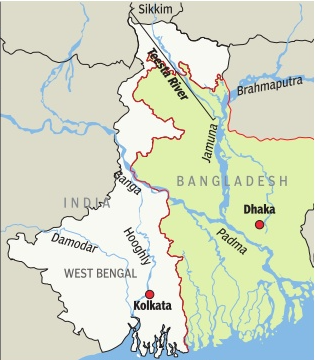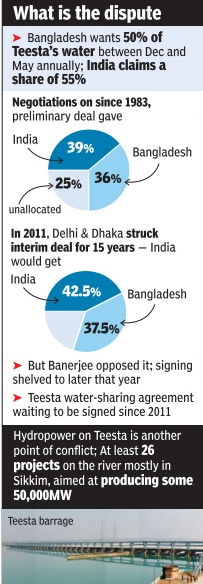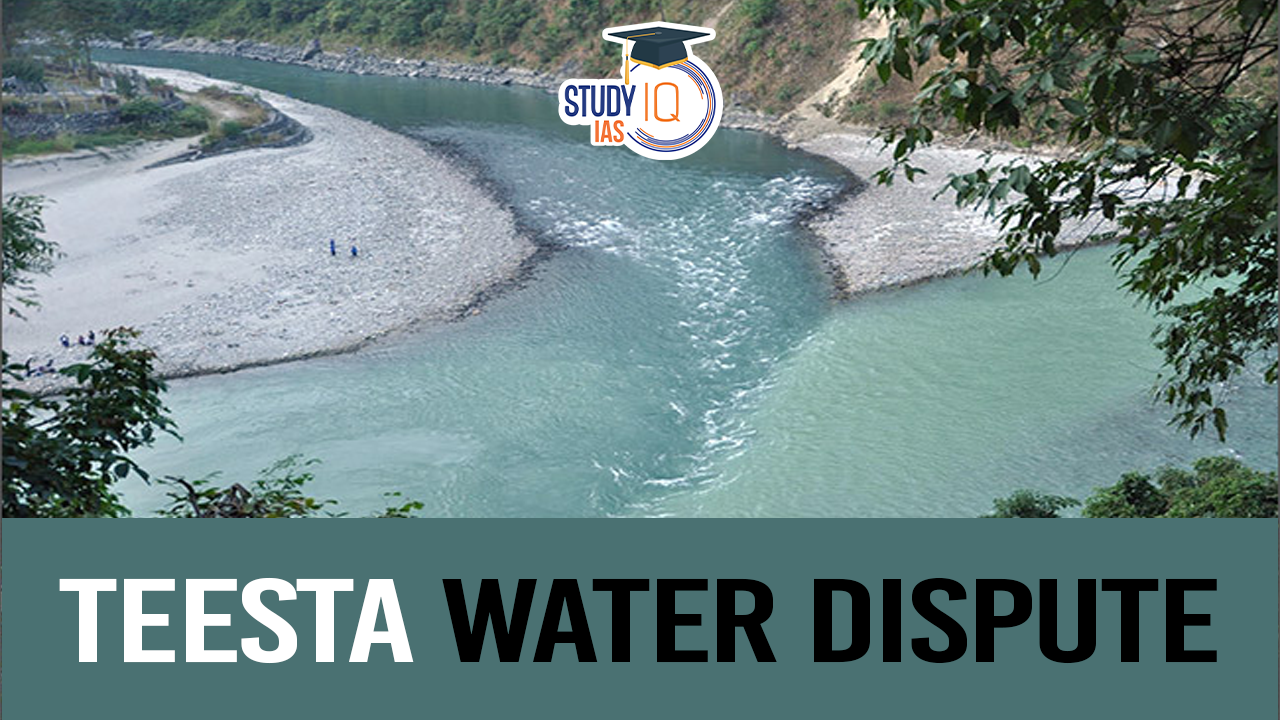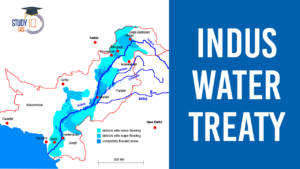Table of Contents
The Chief Minister of West Bengal wrote to the Prime Minister, stating that discussions on the Teesta River treaty with Bangladesh should not proceed without involving the state government.
Teesta River
The Teesta River is a tributary of the Brahmaputra River (known as Jamuna in Bangladesh) and flows through India and Bangladesh (only 17%). It has a potential source for hydropower projects due to its rapid flow through steep terrains in Sikkim.

Origin of Teesta River
- It originates in the Himalayas near the Tso Lhamo Lake, in Sikkim Himalayas, near the border with Tibet.
- It forms a boundary between Sikkim and West Bengal.
- Khangse Glacier and Chho Lhamo are considered sources of the Teesta River by many authors.
- The total length of the river is 309 km (192 mi), and it drains an area of 12,540 km².
Course of River Teesta
- It passes through the plains of West Bengal and enters Bangladesh, where it joins the Brahmaputra River (known as the Jamuna in Bangladesh).
- Flows southward, cutting a deep gorge through the Siwalik Hills east of Darjeeling (West Bengal).
- Turns southeast to run through the Sivok Khola pass (Darjeeling) onto the plains of West Bengal.
- Initially emptied directly into the upper Padma River (Ganga River).
- Around 1787, the river changed its course to flow eastward, crossing the Rangpur region of Bangladesh to join the Brahmaputra River near Chilmari after a total course of about 320 km (200 miles).

Major large barrages constructed on Teesta
- Gajoldoba, Teesta Barrage in West Bengal, India.
- Duani in Bangladesh.
Major Tributaries of Teesta River
- Left-bank Tributaries: Lachung Chhu, Chakung Chhu, Dik Chhu, Rani Khola and Rangpo Chhu.
- Right-bank Tributaries: Zemu Chhu, Rangyong Chhu and Rangit River.
Teesta Water Dispute
The Teesta Water Dispute is a long-standing issue between India and Bangladesh concerning the sharing of the waters of the Teesta River, which originates in the Indian state of Sikkim and flows through the northern part of West Bengal before entering Bangladesh.
Key Points of Teesta Water Dispute
- Historical Context: The Teesta River is crucial for both West Bengal (India) and northern Bangladesh, providing irrigation and supporting agriculture in both regions. The dispute over water sharing dates back to the time of the partition of India in 1947.
- Interim Agreement: In 1983, an ad hoc agreement was reached, which allocated 39% of Teesta’s water to India and 36% to Bangladesh during the dry season, leaving the remaining 25% unallocated. However, this agreement was never formalized into a permanent treaty.
- Proposed Agreement of 2011: A new water-sharing agreement was proposed in 2011, which suggested a more equitable distribution of water. According to reports, the draft agreement proposed India receiving 42.5% of the water and Bangladesh receiving 37.5%. However, the deal was not finalized due to opposition from the West Bengal government, which argued that the proposed distribution would adversely affect the state’s farmers.
- Current Status: As of now, no final agreement has been reached, and negotiations continue. The issue remains a sensitive political matter, affecting bilateral relations between India and Bangladesh.
- Importance to Bangladesh: For Bangladesh, the Teesta River is a vital source of water, particularly during the dry season (October to April). The lack of a stable water-sharing agreement has led to significant water shortages in the country’s northern regions, affecting agriculture and livelihoods.
- Indian Perspective: From the Indian side, particularly in West Bengal, there is concern that releasing more water to Bangladesh could lead to water scarcity in the state’s northern districts, impacting agriculture and local communities.
Water-Sharing Dispute Between India and Bangladesh
- No official treaty exists on Teesta water-sharing.
- Interim agreement proposed in 2011: India agreed to give Bangladesh 5% of Teesta’s water, while India would retain 42.5% (the remaining water was for ecological flow).
- This agreement was not signed due to opposition from the West Bengal government.
- Due to India’s reluctance, Bangladesh has welcomed Chinese investment in the “Teesta River Comprehensive Management and Restoration Project.“
Impact and Significance
The Teesta Water Dispute is not just about water sharing; it also reflects broader issues of regional cooperation, resource management, and diplomatic relations in South Asia. Resolving this dispute is crucial for fostering better relations between India and Bangladesh and ensuring sustainable development and water security in the region.


 Use of AI in Weather Forecasting in Indi...
Use of AI in Weather Forecasting in Indi...
 Cabinet Committee on Security Suspends I...
Cabinet Committee on Security Suspends I...
 Places in News for UPSC 2025 for Prelims...
Places in News for UPSC 2025 for Prelims...





















